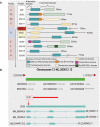Biological functions and therapeutic potential of SRY related high mobility group box 5 in human cancer
- PMID: 38835366
- PMCID: PMC11148273
- DOI: 10.3389/fonc.2024.1332148
Biological functions and therapeutic potential of SRY related high mobility group box 5 in human cancer
Abstract
Cancer is a heavy human burden worldwide, with high morbidity and mortality. Identification of novel cancer diagnostic and prognostic biomarkers is important for developing cancer treatment strategies and reducing mortality. Transcription factors, including SRY associated high mobility group box (SOX) proteins, are thought to be involved in the regulation of specific biological processes. There is growing evidence that SOX transcription factors play an important role in cancer progression, including tumorigenesis, changes in the tumor microenvironment, and metastasis. SOX5 is a member of SOX Group D of Sox family. SOX5 is expressed in various tissues of human body and participates in various physiological and pathological processes and various cellular processes. However, the abnormal expression of SOX5 is associated with cancer of various systems, and the abnormal expression of SOX5 acts as a tumor promoter to promote cancer cell viability, proliferation, invasion, migration and EMT through multiple mechanisms. In addition, the expression pattern of SOX5 is closely related to cancer type, stage and adverse clinical outcome. Therefore, SOX5 is considered as a potential biomarker for cancer diagnosis and prognosis. In this review, the expression of SOX5 in various human cancers, the mechanism of action and potential clinical significance of SOX5 in tumor, and the therapeutic significance of Sox5 targeting in cancer were reviewed. In order to provide a new theoretical basis for cancer clinical molecular diagnosis, molecular targeted therapy and scientific research.
Keywords: SRY associated high mobility population box 5 (SOX5); biomarker; cancer; oncogene; targeted therapy.
Copyright © 2024 Xue, Xiang, Cai and Lv.
Conflict of interest statement
The authors declare that the research was conducted in the absence of any commercial or financial relationships that could be construed as a potential conflict of interest.
Figures



Similar articles
-
The role of SOX family members in solid tumours and metastasis.Semin Cancer Biol. 2020 Dec;67(Pt 1):122-153. doi: 10.1016/j.semcancer.2019.03.004. Epub 2019 Mar 23. Semin Cancer Biol. 2020. PMID: 30914279 Review.
-
Cloning and characterization of SOX5, a new member of the human SOX gene family.Genomics. 1996 Sep 1;36(2):354-8. doi: 10.1006/geno.1996.0474. Genomics. 1996. PMID: 8812465
-
Identification and characterization of the human long form of Sox5 (L-SOX5) gene.Gene. 2002 Sep 18;298(1):59-68. doi: 10.1016/s0378-1119(02)00927-7. Gene. 2002. PMID: 12406576
-
Integrative analysis of the SOX family-related prognostic signature and immunological infiltration in prostate cancer.Transl Cancer Res. 2023 Aug 31;12(8):2048-2062. doi: 10.21037/tcr-23-501. Epub 2023 Aug 28. Transl Cancer Res. 2023. PMID: 37701109 Free PMC article.
-
Novel role of the SRY-related high-mobility-group box D gene in cancer.Semin Cancer Biol. 2020 Dec;67(Pt 1):83-90. doi: 10.1016/j.semcancer.2019.07.011. Epub 2019 Jul 26. Semin Cancer Biol. 2020. PMID: 31356865 Review.
Cited by
-
The SOX gene superfamily in oncogenesis: unraveling links to ncRNAs, key pathways, chemoresistance, and gene editing approaches.Naunyn Schmiedebergs Arch Pharmacol. 2025 May 20. doi: 10.1007/s00210-025-04229-1. Online ahead of print. Naunyn Schmiedebergs Arch Pharmacol. 2025. PMID: 40392306 Review.
-
The long noncoding RNA MIR4435-2HG enhances the migration, promotion, and glycolysis of nonsmall cell lung cancer cells by targeting the miR-371a-5p/SOX2/PI3K/Akt axis.SAGE Open Med. 2024 Nov 8;12:20503121241289290. doi: 10.1177/20503121241289290. eCollection 2024. SAGE Open Med. 2024. PMID: 39526092 Free PMC article.
References
Publication types
LinkOut - more resources
Full Text Sources
Miscellaneous

